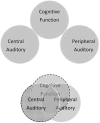Central presbycusis: a review and evaluation of the evidence
- PMID: 22967738
- PMCID: PMC5898229
- DOI: 10.3766/jaaa.23.8.5
Central presbycusis: a review and evaluation of the evidence
Abstract
Background: The authors reviewed the evidence regarding the existence of age-related declines in central auditory processes and the consequences of any such declines for everyday communication.
Purpose: This report summarizes the review process and presents its findings.
Data collection and analysis: The authors reviewed 165 articles germane to central presbycusis. Of the 165 articles, 132 articles with a focus on human behavioral measures for either speech or nonspeech stimuli were selected for further analysis.
Results: For 76 smaller-scale studies of speech understanding in older adults reviewed, the following findings emerged: (1) the three most commonly studied behavioral measures were speech in competition, temporally distorted speech, and binaural speech perception (especially dichotic listening); (2) for speech in competition and temporally degraded speech, hearing loss proved to have a significant negative effect on performance in most of the laboratory studies; (3) significant negative effects of age, unconfounded by hearing loss, were observed in most of the studies of speech in competing speech, time-compressed speech, and binaural speech perception; and (4) the influence of cognitive processing on speech understanding has been examined much less frequently, but when included, significant positive associations with speech understanding were observed. For 36 smaller-scale studies of the perception of nonspeech stimuli by older adults reviewed, the following findings emerged: (1) the three most frequently studied behavioral measures were gap detection, temporal discrimination, and temporal-order discrimination or identification; (2) hearing loss was seldom a significant factor; and (3) negative effects of age were almost always observed. For 18 studies reviewed that made use of test batteries and medium-to-large sample sizes, the following findings emerged: (1) all studies included speech-based measures of auditory processing; (2) 4 of the 18 studies included nonspeech stimuli; (3) for the speech-based measures, monaural speech in a competing-speech background, dichotic speech, and monaural time-compressed speech were investigated most frequently; (4) the most frequently used tests were the Synthetic Sentence Identification (SSI) test with Ipsilateral Competing Message (ICM), the Dichotic Sentence Identification (DSI) test, and time-compressed speech; (5) many of these studies using speech-based measures reported significant effects of age, but most of these studies were confounded by declines in hearing, cognition, or both; (6) for nonspeech auditory-processing measures, the focus was on measures of temporal processing in all four studies; (7) effects of cognition on nonspeech measures of auditory processing have been studied less frequently, with mixed results, whereas the effects of hearing loss on performance were minimal due to judicious selection of stimuli; and (8) there is a paucity of observational studies using test batteries and longitudinal designs.
Conclusions: Based on this review of the scientific literature, there is insufficient evidence to confirm the existence of central presbycusis as an isolated entity. On the other hand, recent evidence has been accumulating in support of the existence of central presbycusis as a multifactorial condition that involves age- and/or disease-related changes in the auditory system and in the brain. Moreover, there is a clear need for additional research in this area.
American Academy of Audiology.
Figures

References
-
- Akeroyd M. Are individual differences in speech reception related to individual differences in cognitive ability? A survey of twenty experimental studies with normal and hearing-impaired adults. Int J Audiol. 2008;47(Suppl. 2):S53–S71. - PubMed
-
- Alain C, McDonald KL, Ostroff JM, Schneider B. Aging: a switch from automatic to controlled processing of sounds? Psychol Aging. 2004;19:125–133. - PubMed
-
- American National Standards Institute. ANSI S3.5-1997. American National Standard Methods for the Calculation of the Speech Intelligibility Index. New York: American National Standards Institute; 1997.
-
- Bacon SP, Viemeister NF. Temporal modulation transfer functions in normal-hearing and hearing-impaired listeners. Audiology. 1985;24:117–134. - PubMed
-
- Baltes PB, Lindenberger U. Emergence of a powerful connection between sensory and cognitive function across the adult life span: a new window to the study of cognitive aging? Psychol Aging. 1997;12:12–21. - PubMed
Publication types
MeSH terms
Grants and funding
LinkOut - more resources
Full Text Sources
Other Literature Sources
Miscellaneous
